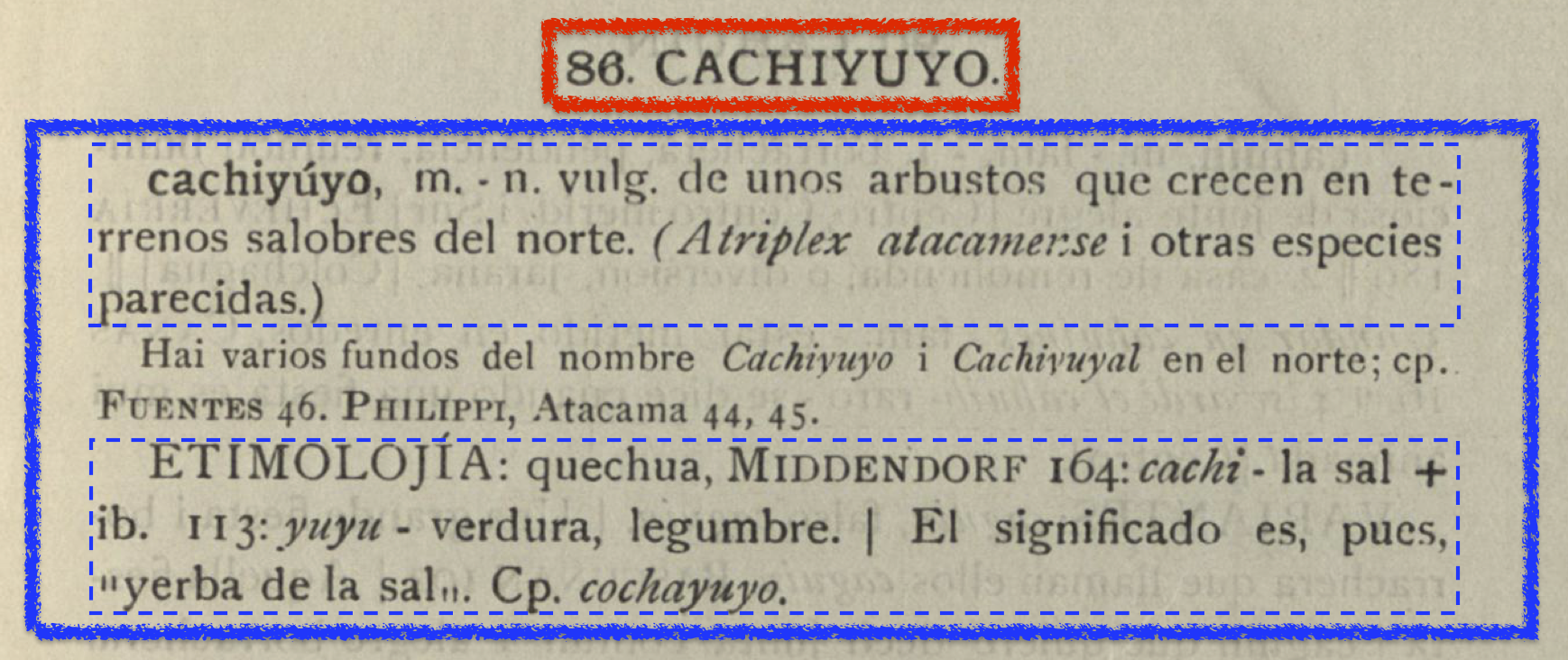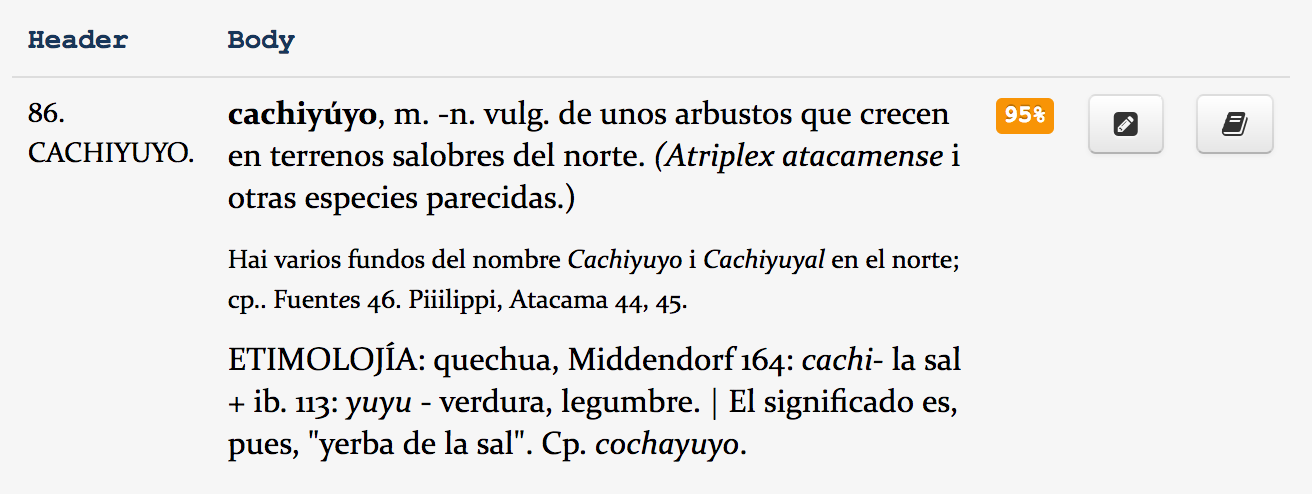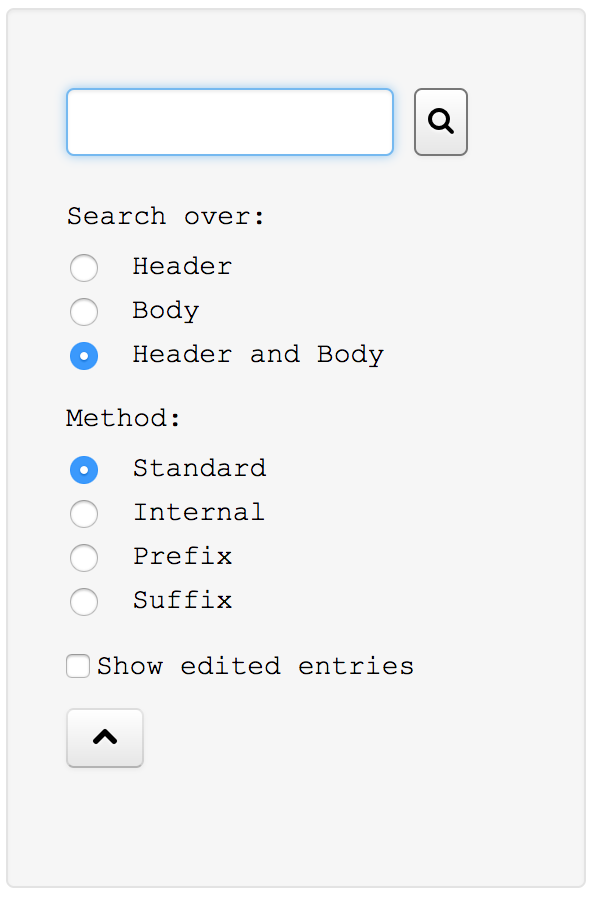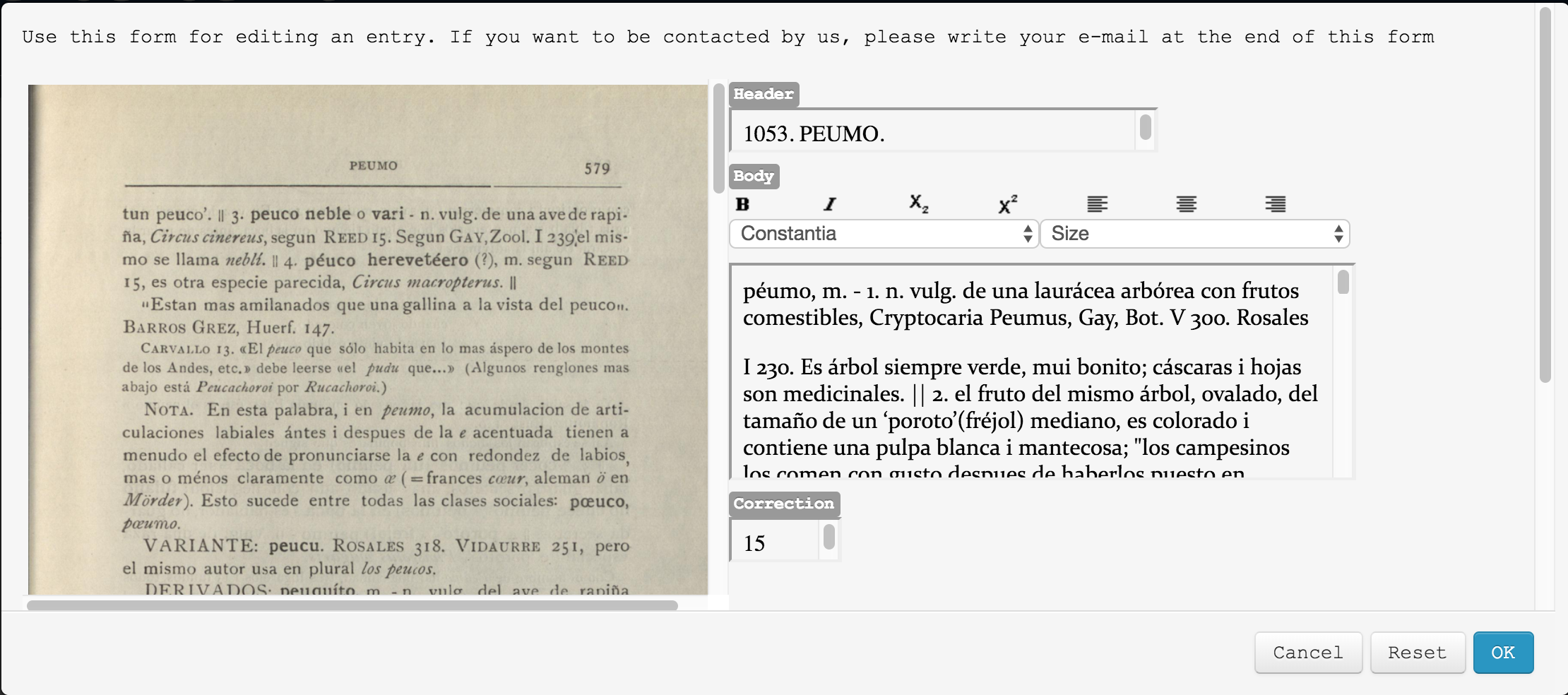About the devochdelia
Overview
This website contains a digital version of the Etymological Dictionary of Chilean Voices derived from American indigenous languages, compiled by Rodolfo Lenz at the beginning of the s. XX.
Devochdelia is the acronym for the title of this dictionary, but at the same time, it refers to the digital version.
The devochdelia is the fruit of an academic project that seeks to bring Lenz's work closer to the general public.
The process reaching to the devochdelia can be summarized in the following stages:
- A printed edition of the dictionary (1905-1910) has been scanned by the university and city library of Cologne, Germany
- 1665 entries were extracted from the scanned edition using optical character recognition software
- All headers of the 1665 extracted entries have been corrected. The body of the first 1000 has been partially corrected
The 1665 entries extracted after the OCR and correction process have been imported into an adapted version of Maalr, a framework developed by the department of computational linguistics at the University of Cologne.
The ultimate goal of the devochdelia is to completely correct the 1665 entries present in it.
Entries in the print edition in relation to entries in the devochdelia

Two structures can be observed in each entry: first, the indigenous word, numbered and in capital letters. We call this structure a header in the devochdelia. It is marked in red in the image.
The second structure, the body, contains the Chilean words or phrases derived from the indigenous one in the header. In most cases, the difference between the two words can be seen in the accentuation of the Chileans.
When referring to the etymologies, Lenz points out: "Conservo exactamente la ortografía de la palabra indíjena, los significados se dan en ortografía moderna o entre comillas en la del orijinal." (Lenz 1905-1910:58).
Lenz uses the "modern Castilian orthography", specifically Andrés Bello's version "... de uso oficial en Chile, e indudablemente preferible a la académica." (Lenz 1905-1910:92). This orthography was officially used in Chile between 1844 and 1927.
More details about the structure of the body can be found on pages 56-58 of the introduction. More information about the spelling used, including phonetic notation, can be found on pages 92-102 of the same section here.
Entries in the devochdelia

Thus, an entry in the devochdelia contains three elements: header, body, and correction. On the results page, to these three elements two buttons are added, clicking on
| a. | adjective that forms the feminine ending on -a. |
| ac. | primary meaning; followed by ac.2, ac.3, etc. |
| adj. | invariable adjective for the feminine form. |
| adj.invar | adjective that does not take a feminine or plural ending. |
| adv. | adverb. |
| ant. | outdated. |
| bajo | speech that is considered more or less indecent. |
| cp. | comparative. |
| dim. | diminutive. |
| etn. | term used by Chilean ethnographers such as Medina and Guevara. |
| esp. | especially. |
| f. | feminine noun. |
| fam. | familiar term, used in conversation by educated people, but rarely written. |
| hist. | term used by the historians of Chile but which is not used nowadays. |
| id. | idem, citation of the same author. |
| ibid. | ibidem, citation of the same book. |
| jen. | generally. |
| lat. | latin. |
| l.c. | loco citato, quoted in the same passage above/before. |
| lit. | literary term, meaning that it is used in Chile with some frequency in writing and in print, at least in the daily press. |
| m. | masculine noun. |
| map. | Mapuche, language of the Indians of Chile, commonly called Araucanians or better, Mapuches. |
| mar. | term used by sailors or fishermen. |
| min. | term used by miners. |
| n.p. | proper name. |
| n. vulg. | common name, as opposed to scientific terms. |
| ort. | spelling. |
| p. ej. | for example. |
| plur. | plural. |
| quech. | Quechua language or the language of the Peruvian Indians or Incas. |
| raro | rare term, rarely used. |
| sig. | and following. |
| s.v. | sub voce, see the corresponding word in the dictionary. |
| sust. | masculine or feminine noun, depending on the ending. |
| tb. | also. |
| var. | another form or spelling of the same word. |
| vulg. | vulgar speech, used among low people, rarely used by educated people. |
(Lenz 1905-1910:105f)
| ? | false form; word that has been considered Chilean without being so; particularly Indian speeches that Gay mentions as vulgar Chilean. |
| | | end of a citation. |
| || | end of a meaning. |
| < | a < b means: a is etymologically derived from b. |
| > | a > b means: b derives from a. |
| ' ' | '...' generally contains words explained in the definitions of other words within the same dictionary. |
| [ ] | heading in parentheses, a word that has been considered to be of American origin, without being so. In the text [...] generally contains geographical indications that have been dropped from the use of the word. |
| * | current speech used in Santiago. |
(Lenz 1905-1910:117)
The default search is done both in the lemma and in the definition of an entry.
By clicking on ![]() you will see the advanced search options:
you will see the advanced search options:
 Once the advanced search menu is open, you can choose which fields you want to search: header, body or both fields.
Once the advanced search menu is open, you can choose which fields you want to search: header, body or both fields.
TYou have 5 search methods at your disposal:
- The standard method is used by default and combines the different search strategies.
- The inner method allows you to search within a word. For example, when searching for nac, you might see results like CANACA.
- The prefix method allows you to search for the first letters of each word. For example, when searching for hua, you might see results like HUACHAPEAR.
- The suffix method method allows you to search for the last letters of each word. For example, when searching for co, you might see results like PACO.
The 'View edited entries' option allows you to view entries that match your search and have been edited, but not approved by the devochdelia administrator.
To close the advanced search menu, click

The guiding principle of this project is that the digital version of the dictionary should be as similar as possible to the printed version.
The only exceptions to this principle are the authors cited by Lenz within the dictionary. In the print edition the cited authors are in small caps, for example: Middendorf.
You can just skip this markup and edit cited authors, just as you would any last name. The result should look like this in the editor: Middendorf.
To open the post editor, click the ![]() button found on each post. Once the post editor is open, you can modify three fields: header, body and correction.
button found on each post. Once the post editor is open, you can modify three fields: header, body and correction.
The 1665 headings of the devochdelia have been corrected and can be searched without problems through the search bar on the main page.
Of the 1665 entries present, only 1000 have been corrected by one person. This is why they are marked as 95% correct. If you review these entries - compare the content with the original source - and conclude that they do not need to be corrected, increase the correction percentage to 100%.
With this action you are informing other users and the site administrator that the entry is fully corrected.
Starting with entry 1001, all entries have been marked by default with 15% correctness. This means that no one has reviewed them. We recommend that if you correct any of these entries and you believe they are error-free, mark those entries as 95% correct.
This way, you can tell other users to review the entry. If another user finds no errors, the entry can finally be marked as 100% correct.
IMPORTANT: If you modify the header or body of an entry, update the correction percentage also. If you do not enter a new value for the correctness, your changes will not be saved!
The Toolbar
The editing toolbar has been specially adapted for editing the devochdelia entries.
You may use the 'Constantia' font. This font is applied to all entries by default. In fact, this font is the only available font option selectable through the toolbar.
Available font sizes are 'Standard' and 'Note'. 'Standard' is the size used by default - marked with a dashed blue line in 'cachiyuyo' - and 'Note' is the one used in notes and comments - unmarked in the same entry.

